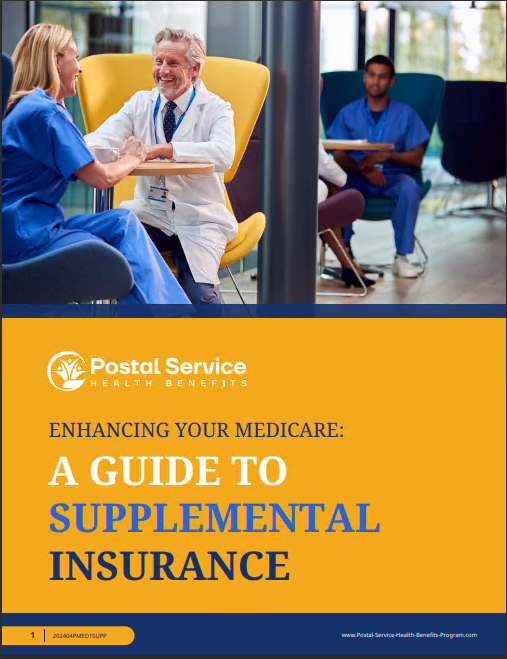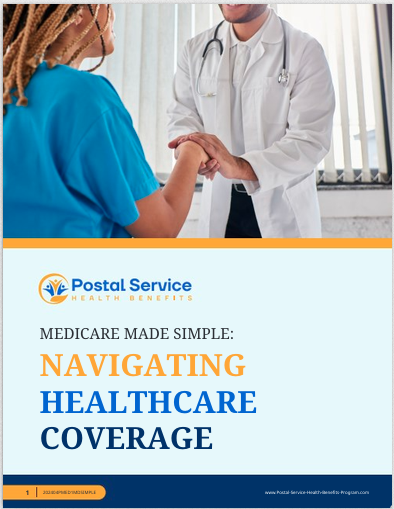Key Takeaways:
-
Medigap plans can complement Medicare coverage under the Postal Service Health Benefits (PSHB) program, filling coverage gaps and lowering out-of-pocket costs.
-
By integrating Medigap and PSHB, you can achieve a robust healthcare strategy tailored to your needs as a Postal Service retiree or employee.
Understanding the Basics of PSHB and Medicare
The Postal Service Health Benefits (PSHB) program works closely with Medicare to provide comprehensive healthcare coverage for Postal Service retirees and their eligible family members. If you’re eligible for Medicare, your PSHB plan becomes your secondary coverage, helping to cover costs that Medicare alone wouldn’t, such as copayments, coinsurance, and deductibles.
While PSHB already enhances your Medicare coverage, it doesn’t eliminate all out-of-pocket expenses. That’s where Medigap (Medicare Supplement Insurance) plans step in, offering an additional layer of financial protection. These plans are designed to fill the gaps in Medicare Part A and Part B coverage, ensuring you’re not burdened by unexpected medical bills.
What Does Medicare Cover?
To understand how Medigap plans can help, let’s quickly recap what Medicare covers:
-
Part A (Hospital Insurance): Covers inpatient hospital stays, skilled nursing facility care, hospice care, and some home health services. However, there are deductibles and coinsurance you’re responsible for.
-
Part B (Medical Insurance): Covers outpatient care, doctor visits, preventive services, and medical supplies. Like Part A, Part B comes with a standard premium, annual deductible, and coinsurance.
While these parts provide essential coverage, gaps like deductibles, coinsurance, and foreign travel emergencies can add up. PSHB plans coordinate with Medicare to alleviate some of these costs, but they may still leave you exposed to out-of-pocket expenses.
Filling the Gaps with Medigap Plans
Medigap plans, sold by private insurers, are standardized across most states and categorized into ten plan types, labeled A through N. These plans are designed to:
-
Cover Medicare Part A coinsurance and hospital costs.
-
Pay Part B coinsurance or copayments.
-
Offset Part A and Part B deductibles (depending on the plan).
-
Provide foreign travel emergency coverage (up to plan limits).
By integrating a Medigap plan with PSHB, you can:
-
Minimize Out-of-Pocket Costs: Medigap can cover what Medicare and PSHB don’t, reducing your financial liability.
-
Enhance Coverage: Some plans offer additional benefits like excess charges for Part B services and emergency care abroad.
-
Simplify Healthcare Costs: Predictable premiums make budgeting easier compared to variable out-of-pocket expenses.
How PSHB and Medigap Plans Work Together
When you enroll in Medicare and PSHB, Medicare becomes your primary insurance. It pays first for covered services. PSHB then steps in as secondary insurance, covering some costs Medicare doesn’t. Adding a Medigap plan creates a coordinated system where:
-
Medicare Pays First: Covers a portion of your approved healthcare costs.
-
Medigap Pays Second: Handles the remaining eligible expenses, such as deductibles and coinsurance.
-
PSHB Pays Last: Fills any remaining gaps, offering a triple layer of financial protection.
This three-tiered approach ensures you’re fully covered for most healthcare needs, minimizing surprises when medical bills arrive.
Who Benefits the Most from Medigap Plans?
Not everyone needs a Medigap plan. However, you might benefit if:
-
You have frequent medical appointments or ongoing treatments.
-
You’re concerned about high out-of-pocket costs from unexpected hospitalizations.
-
You plan to travel abroad and need coverage for medical emergencies outside the U.S.
For retirees already enrolled in Medicare and PSHB, a Medigap plan can add peace of mind, especially for those who want to avoid unpredictable healthcare expenses.
Choosing the Right Medigap Plan
Selecting the best Medigap plan depends on your healthcare needs, budget, and expected usage. Here are some steps to guide your decision:
-
Evaluate Your Needs: Consider your current health status, frequency of doctor visits, and any ongoing treatments.
-
Understand Standardized Plans: All Medigap plans with the same letter offer identical benefits, no matter the insurer. Focus on coverage, not the brand.
-
Compare Costs: While premiums vary, choose a plan that balances affordability with comprehensive benefits.
-
Check State-Specific Rules: Some states may have unique regulations affecting Medigap eligibility and enrollment.
Enrollment Periods: Timing Matters
Enrolling in a Medigap plan is easiest during your Medigap Open Enrollment Period, which begins when you turn 65 and are enrolled in Medicare Part B. This six-month window allows you to purchase any Medigap policy without medical underwriting. After this period, you may face restrictions or higher costs based on your health.
If you’re transitioning from active employment to retirement and joining PSHB and Medicare, ensure your Medigap enrollment aligns with these changes. Missing enrollment deadlines could limit your options.
Common Questions About Medigap and PSHB Integration
Can I Keep My PSHB Plan If I Add Medigap?
Yes. Medigap plans complement Medicare, and your PSHB plan continues to act as secondary insurance. However, review your PSHB plan’s benefits to avoid overlapping coverage.
Do I Need Both PSHB and Medigap?
It depends on your healthcare needs and budget. PSHB plans already offer robust coverage, but Medigap can provide added financial protection if you’re worried about gaps Medicare and PSHB don’t address.
Will Medigap Cover Prescription Drugs?
No, Medigap plans do not include prescription drug coverage. If you need help with medication costs, ensure your PSHB plan includes a comprehensive drug benefit or consider a standalone Medicare Part D plan.
Balancing Costs and Benefits
While the combination of Medigap and PSHB offers extensive coverage, it’s essential to balance the costs. Consider the following:
-
Premiums: Adding a Medigap plan means paying an additional premium. Ensure it fits within your retirement budget.
-
Coverage Needs: Review how much financial risk you’re willing to take on without a Medigap plan.
-
Plan Compatibility: Confirm that your Medigap plan works seamlessly with your PSHB coverage.
Remember, healthcare is a significant part of retirement planning. Spending a bit more on premiums now could save you from unexpected expenses later.
The Role of Medicare Part B in Your Coverage
Medicare Part B enrollment is mandatory for maintaining PSHB coverage if you’re eligible. This requirement is designed to ensure comprehensive coordination of benefits. When combined with Medigap, Part B becomes even more powerful, as it reduces your out-of-pocket costs for outpatient services.
By meeting the Part B requirement, you unlock access to PSHB’s secondary benefits and create a solid foundation for integrating Medigap into your healthcare strategy.
Final Steps for a Comprehensive Coverage Strategy
If you’re considering adding a Medigap plan to your PSHB and Medicare coverage, follow these steps:
-
Review Your Current Coverage: Assess what Medicare and PSHB already provide.
-
Identify Gaps: Pinpoint areas where you might face financial risk, such as coinsurance or deductibles.
-
Research Medigap Plans: Compare available plans, focusing on benefits and premiums.
-
Consult Experts: Reach out to a licensed insurance advisor or Medicare specialist for tailored advice.
-
Enroll Timely: Avoid late penalties by enrolling during your Medigap Open Enrollment Period.
By taking these steps, you’ll be better equipped to make informed decisions and secure a healthcare plan that suits your needs.
Strengthen Your Healthcare Coverage Today
The synergy between Medigap, Medicare, and PSHB creates a powerful safety net for your healthcare needs. By understanding how these plans work together, you can build a strategy that minimizes costs and maximizes benefits. Take charge of your coverage to ensure a worry-free retirement and greater peace of mind.







